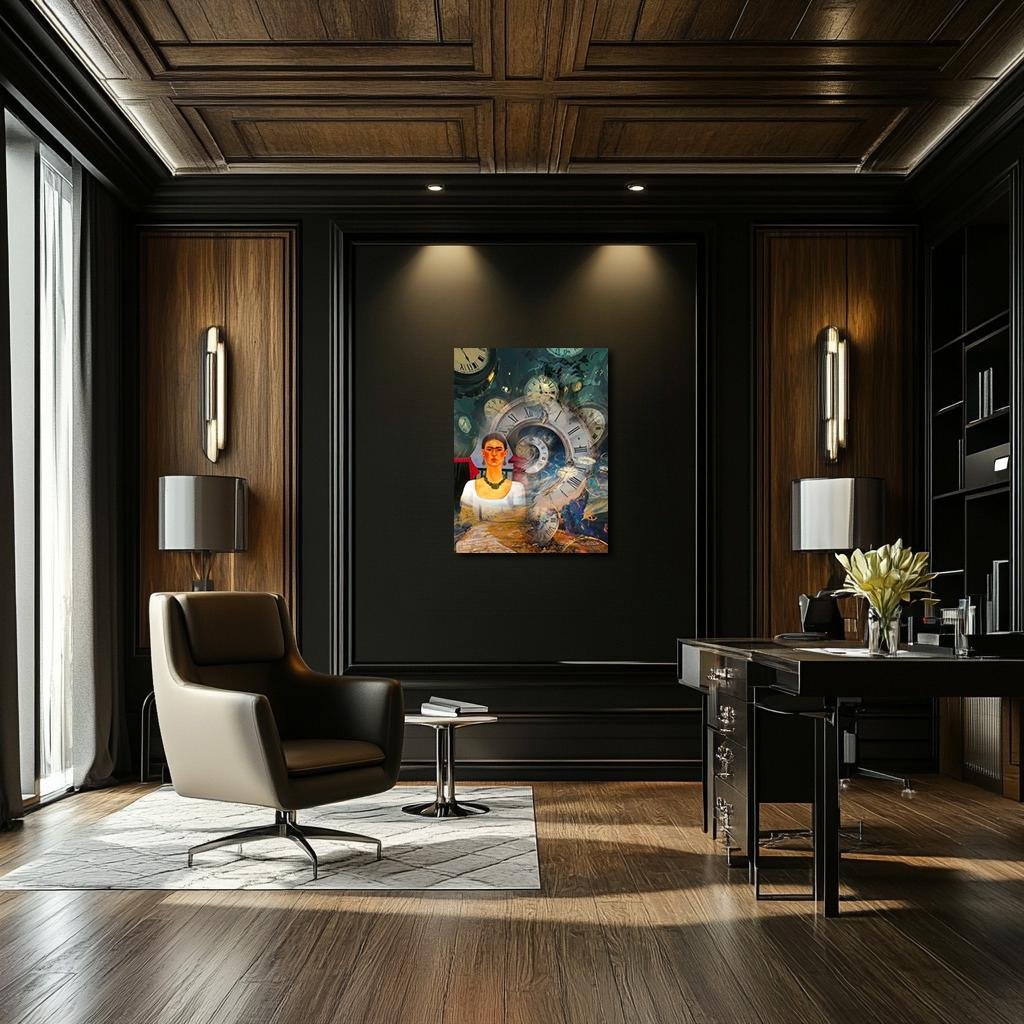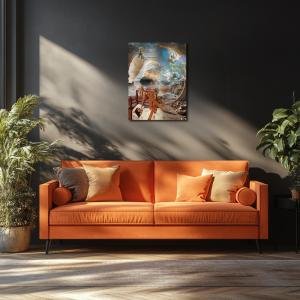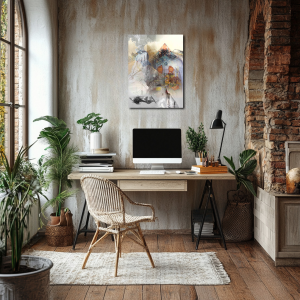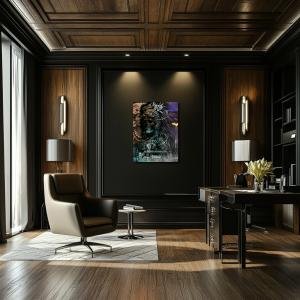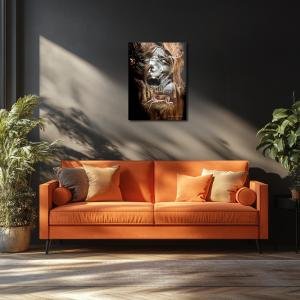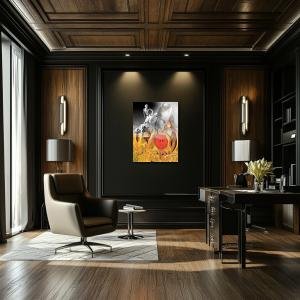Chronos Unbound: Frida’s Spiral of Endurance
Chronos Unbound reimagines Frida Kahlo’s Time Flies as a spiraling confrontation with the disintegration of time. Amid fractured clocks and mechanical storm, Kahlo stands rooted in sienna and green, unshaken by the swirl of collapsing chronology. With a palette of bruised blue, faded gold, and warm earth, this work portrays her not as a victim of passing time, but as its quiet witness and eternal mirror. The world spins, the hours scatter, but she remains—framed in stillness, bearing time’s weight with fierce presence.
Please see Below for Details…
Hotline Order:
Mon - Fri: 07AM - 06PM
404-872-4663
This conceptual reimagining of Frida Kahlo’s Time Flies unfolds as a surreal testament to endurance within the shifting currents of time, identity, and existential reflection. Titled Chronos Unbound , the piece swirls around the core of Kahlo’s stillness as though trying to erase her, rush past her, redefine her—yet she remains unyielding. Her image, poised and unmoved, anchors the chaos of clocks, broken moments, and collapsing timelines. It is not just a portrait; it is a meditation on time as both tormentor and companion.
Kahlo stands in the lower left quadrant, lifted from her original self-portrait, her body subtly glowing in front of an earthy path that winds toward the vortex of collapsing timepieces. Her calm face and straight posture act as an emotional counterweight to the surrounding spiral of clocks. Her expression is not defiance, but resolute presence—a quiet refusal to be swept into the unraveling. Time flies, but she stands.
Behind her, time is not linear. It is a vortex, a spiral of Roman numerals and fractured mechanisms spinning out of control. Giant clock faces loom, distorted and bent, some cracked with age, others melting into each other like echoes of Salvador Dalí’s dreamscapes. This is no ordinary landscape—it is a collapsing metaphysical terrain where hours are ghosts and seconds are ash.
The background churns with a storm of color and mechanical debris. Broken clock hands scatter like arrows, circling above as if they’ve lost direction. Faint silhouettes drift across the spiral’s center—echoes of memory, perhaps earlier versions of self, perhaps reminders of time lost or stolen.
Yet in this storm, Frida is not diminished. She wears a deep green beaded necklace—earthy and grounding—and a stark white blouse that radiates stillness. Her skin is painted in warm sienna and rose, her cheeks touched with burnt peach. These grounded, flesh-based tones resist the cold hues around her. She is rooted in presence, not chronology.
The color palette of Chronos Unbound dances between muted despair and fiery defiance. The upper half of the piece swirls with deep navy, tarnished brass, and a bruised midnight blue—the colors of timeworn metal and dreamless sleep. The clocks themselves are rendered in a mix of metallic gold, faded silver, and pale bone-white, giving the impression of relics dug from the sands of centuries. Cracks run through them like lightning frozen in porcelain.
Between the gears and spirals, flashes of electric indigo and cosmic violet streak through, invoking the dimension of the subconscious—the place where time becomes elastic. These colors are cold, but alive, drawing attention to the psychological dislocation often felt in moments of prolonged suffering.
The road beneath Frida’s feet and behind her body is painted in a tapestry of ochre, golden brown, and umber, forming a grounded contrast to the swirling abstraction above. It represents the physical path—painful, rooted, personal—while the sky of time above swirls in universal turbulence. This is where the personal and cosmic meet.
Her necklace—a bold green—is not incidental. It ties her to the earth, to life, to the breath of living things. The green cuts through the surrounding metallic timepieces like a pulse, like sap through bark. In this piece, color becomes emotion made visible: brown and white for the body, gold and blue for time, green for spirit, and red for the fleeting trace of life’s urgency.
When I created Chronos Unbound , I wanted to emphasize the duality that Frida Kahlo carried within her work: a woman deeply anchored in the present moment of her pain, yet constantly aware of the passing of time and the erosion it brought to her body, her love, her country, her memories. In Time Flies , Kahlo’s message was quietly profound—time moves, life slips, and yet we remain. Or at least, we try.
In this vision, she becomes the still point in a spinning world. Time fractures, reforms, rushes past—but she is the observer, the sufferer, the bearer. Unlike the clocks, she does not shatter. She is wounded, yes—but not undone. Her art is her resistance to temporality. Her self-portraits are monuments, not diaries.
The composition flows in a centripetal spiral, drawing the viewer’s eye from the pathway at the bottom upward through the chaotic clockscape. The viewer is invited not only to observe but to feel the distortion of time—to ask where the moment begins and ends, and whether anyone, even time itself, knows the answer.
In this vision, Frida Kahlo becomes not just a painter, not just a sufferer of time, but its challenger. Through stillness, through image, through gaze—she refuses to be erased.
Add your review
Your email address will not be published. Required fields are marked *
Please login to write review!
Looks like there are no reviews yet.

